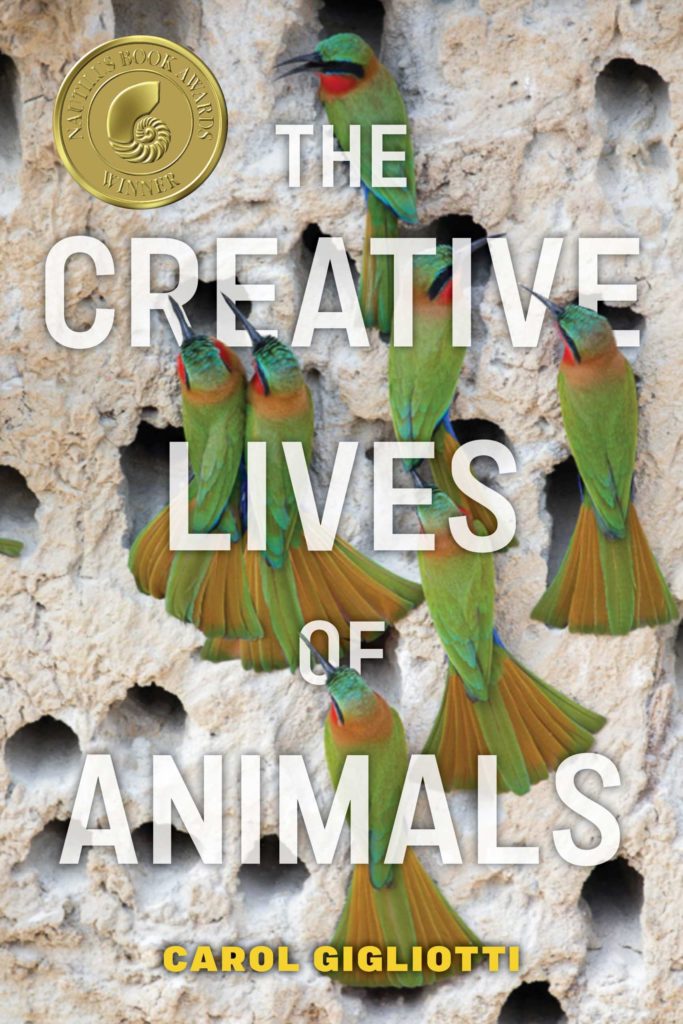
The Creative Lives of Animals
Winner of the 2023 Nautilus Gold Book Award in Animals and Nature
Most of us view animals through a very narrow lens, seeing only bits and pieces of beings that seem mostly peripheral to our lives. However, whether animals are building a shelter, seducing a mate, or inventing a new game, animals’ creative choices affect their social, cultural, and environmental worlds.
The Creative Lives of Animals offers readers intimate glimpses of creativity in the lives of animals, from elephants to alligators to ants. Drawing on a growing body of scientific research, Carol Gigliotti unpacks examples of creativity demonstrated by animals through the lens of the creative process, an important component of creative behavior, and offers new thinking on animal intelligence, emotion, and self-awareness. With examples of the elaborate dams built by beavers or the lavishly decorated bowers of bowerbirds, Gigliotti provides a new perspective on animals as agents in their own lives, as valuable contributors to their world and ours, and as guides in understanding how creativity may contribute to conserving the natural world. Presenting a powerful argument for the importance of recognizing animals as individuals and as creators of a healthy, biodiverse world, this book offers insights into both the established and emerging questions about the creativity of animals.
Cover Photo @ Melissa Groo

PRAISE
“The Creative Lives of Animals is a game-changer. Carol Gigliotti shows how important creativity –improvisation and invention–is in a wide variety of contexts including expressing different emotions, playing, socially communicating with others, courting, mating, and raising children, and designing and engineering animals’ homes. Easy-to-read and science-based, The Creative Lives of Animals will be of interest to a broad audience including researchers and non-researchers alike, and surely will change the ways in which humans view and treat the fascinating animals with whom we share our magnificent planet.” ― Marc Bekoff, author of Canine Confidential: Why Dogs Do What They Do
“Gigliotti’s palpable love of the animal world is expressed in graceful and affecting prose… the author deserves praise for creating this beautiful prose paean to the other animals who inhabit our shared world.” — D. Altschiller, Boston University ― CHOICE
About the author
Carol Gigliotti is an author, artist, animal activist, and scholar whose work focuses on the reality of animals’ lives as important contributors to the biodiversity of this planet. She is Professor Emerita of Design and Dynamic Media and Critical and Cultural Studies at the Emily Carr University of Design, Vancouver, BC. CANADA.
Her newest book, The Creative Lives of Animals, was published by the NYU Press (Nov. 2022)
This work challenges the current assumptions of creativity offering a more comprehensive understanding through recognizing animal creativity, cognition, consciousness, and agency.
She is the editor of the book, Leonardo’s Choice: Genetic Technologies and Animals and the author of numerous book chapters and journal essays on these topics. Her work is supported by the Social Sciences and Humanities Research Council of Canada, The Sitka Center for the Arts, and Coppermoss, among others. Gigliotti is on several international advisory boards concerned either with media or animal studies. Gigliotti has a BSS in Performance Studies, an MFA in Printmaking, and a Ph.D. from the Advanced Computing Center of Arts and Design at The Ohio State University.
She now lives in Eugene, Oregon

